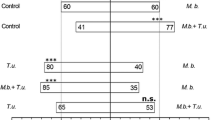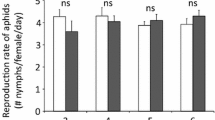Abstract
Damage caused by herbivorous insects and application of phytohormones can activate signaling pathways, which result in greater production of secondary metabolites, increasing plant defenses. This study aimed to evaluate the induced direct resistance (local and systemic) of rice plants caused by herbivorous insects and exogenous application of methyl jasmonate (MJ) and salicylic acid (SA) in the development of fall armyworm, Spodoptera frugiperda (J. E. Smith) (Lepidoptera: Noctuidae). Moreover, indirect defenses through chemotactic responses of Trichogramma pretiosum (Riley) (Hymenoptera: Trichogrammatidae) submitted to the same treatments were investigated. Direct defense was evaluated by measuring weight gain of fall armyworm larvae fed with leaves of plants previously exposed to herbivores or treated with MJ (2 and 5 mM), SA (8 and 16 mM), or control. Indirect defense was verified by chemotactic behavior of wasps in two-choice olfactometer tests to plants exposed to herbivores and evaluated after 24, 48, and 72 h in comparison with undamaged ones, as well as plants treated with the same phytohormones contrasted with the control. The gain of weight was reduced in immature developmental stage of S. frugiperda fed in leaves previously damaged by fall armyworm and in newly formed leaves after damage to the plants, comparing with control. Leaves treated with MJ (2 mM and 5 mM) and SA (8 mM) were less eaten than those not treated. Parasitoids triggered a positive chemotactic behavior in rice plants that had been sprayed with same concentrations. This study showed that rice plants can activate direct and indirect defenses through an exogenous application of phytohormones.




Similar content being viewed by others
References
Agrawal AA (2005) Future directions in the study of induced plant responses to herbivory. J Chem Ecol 115:97–105
Baker JE, Bowling CC (1967) Rearing of two lepidopterous pests of rice on a common artificial diet. Ann Entomol Soc Am 60:1215–1216
Bayram A, Tonga A (2018) Cis-Jasmone treatments affect pests and beneficial insects of wheat (Triticum aestivum L.): the influence of doses and plant growth stages. Crop Prot 105:70–79
Beserra EB, Dias CTDS, Parra JRP (2002) Distribution and natural parasitism of Spodoptera Frugiperda (Lepidoptera: Noctuidae) eggs at different phenological stages of corn. Florida Entomol 85:588–593
Bhonwong A, Stout MJ, Attajarusit J, Tantasawat P (2009) Defensive role of tomato polyphenol oxidases against cotton bollworm Helicoverpa armigera and beet armyworm Spodoptera exigua. J Chem Ecol 35:28–38
Boughton AJ, Hoover K, Felton GW (2006) Impact of chemical elicitor applications on greenhouse tomato plants and population growth of the green peach aphid, Myzus persicae. Entomol Exp Appl 120:175–188
Bruinsma M, Posthumus MA, Mumm R, Mueller MJ, Van Loon JJA, Dicke M (2009) Jasmonic acid-induced volatiles of Brassica oleracea attract parasitoids: effects of time and dose, and comparison with induction by herbivores. J Exp Bot 60:2575–2587
Counce PA, Keisling TC, Mitchell AJ (2000) A uniform, objective, and adaptive system for expressing rice development. Crop Sci 40:436–443
De Moraes CM, Lewis WJ, Pare PW, Alborne HT, Tumlinson JH (1998) Herbivore-infested plants selectively attract parasitoids. Nature 393:570–573
De Sá LAN, Parra JRP, De Sá LAN (1994) Natural parasitism of Spodoptera frugiperda and Helicoverpa zea (Lepidoptera: Noctuidae) eggs in corn by Trichogramma pretiosum (Hymenoptera: Trichogrammatidae) in Brazil. Florida Entomol 77:185
Durrant WE, Dong X (2004) Systemic acquired resistence. Annu Rev Phytopathol 42:185–209
Fatouros NE, Dicke M, Mumm R, Meiners T, Hilker M (2008) Foraging behavior of egg parasitoids exploiting chemical information. Behav Ecol 19:677–689
Ferreira E (1999) Pragas e seu controle. In: Santos AB, Stone LF, Vieira NRA (eds) A cultura do arroz no Brasil. Embrapa Arroz e Feijão, Santo Antônio de Goiás, pp 197–261
Figueiredo M, Cruz I, da Silva RB, Foster JE (2015) Biological control with Trichogramma pretiosum increases organic maize productivity by 19.4%. Agron Sustain Dev 35:1175–1183
Fonseca JR (2006) Recursos genéticos. In: Santos AB, Stone LF, Vieira NRA (eds) A cultura do arroz no Brasil. Embrapa Arroz e Feijão, Santo Antônio de Goiás, pp 257–288
Freitas TFS (2017) Ecologia química de pentatomídeos em Oryza sativa (Poaceae): implicações no manejo com feromônio sexual sintético e nas interações tritróficas mediadas por fitormônios. 2017. 116 f. Tese (Doutorado em Fitotecnia) - Programa de Pós-Graduação em Fitotecnia, Faculdade de Agronomia, Universidade Federal do Rio Grande do Sul, Porto Alegre
Freitas TFS, Stout MJ, Sant’Ana J (2018) Effects of exogenous methyl jasmonate and salicylic acid on rice resistance to Oebalus pugnax. Pest Manag Sci. https://doi.org/10.1002/ps.5174
Girling RD, Stewart-Jones A, Dherbecourt J, Staley JT, Wright DT, Poppy GM (2011) Parasitoids select plants more heavily infested with their caterpillar hosts: a new approach to aid interpretation of plant headspace volatiles. Proc R Soc B Biol Sci 278:2646–2653
Glazebrook J (2005) Contrasting mechanisms of defense against biotrophic and necrotrophic pathogens. Annu Rev Phytopathol 43:205–227
Gordy JW, Leonard BR, Blouin D, Davis JA, Stout MJ (2015) Comparative effectiveness of potential elicitors of plant resistance against Spodoptera frugiperda (J. E. Smith) (Lepidoptera: Noctuidae) in four crop plants. PLoS One 10:1–14
Guerrieri E, Poppy GM, Powell W, Tremblay E, Pennacchio F (1999) Induction and systemic release of herbivore-induced plant volatiles mediating in-flight orientation of Aphidius ervi. J Chem Ecol 25:1247–1261
Hamm JC, Stout MJ, Riggio RM (2010) Herbivore- and elicitor-induced resistance in rice to the rice water weevil (Lissorhoptrus oryzophilus Kuschel) in the laboratory and field. J Chem Ecol 36:192–199
Harborne JB (1999) Classes and functions of secondary products. In: Walton NJ, Brown DE (eds) Chemicals from plants: perspectives on secondary plant products. Imperial College Press, London, pp 1–25
Houseweart MW, Jennings DT, Welty C, Southard SG (1983) Progeny production by Trichogramma minutum (Hymenoptera: Trichogrammatidae) utilizing eggs for Choristoneura fumiferana (Lepidoptera: Tortricidae) and Sitotroga cerealella (Lepidoptera: Gelechiidae). Can Entomol 115:1245–1252
Kanno H, Satoh M, Kimura T, Fujita Y (2005) Some aspects of induced resistance to rice blast fungus, Magnaporthe grisea, in rice plant infested by white-backed planthopper, Sogatella furcifera. Appl Entomol Zool 40:91–97
Kanno H, Hasegawa M, Osamu K (2012) Accumulation of salicylic acid, jasmonic acid and phytoalexins in rice, Oryza sativa, infested by the white-backed planthopper, Sogatella furcifera (Hemiptera: Delphacidae). Appl Entomol Zool 47:27–34
Kawazu K, Mochizuki A, Sato Y, Sugeno W, Murata M, Seo S, Mitsuhara I (2012) Different expression profiles of jasmonic acid and salicylic acid inducible genes in the tomato plant against herbivores with various feeding modes. Arthropod Plant Interact 6:221–230
Ko K, Liu Y, Hou M, Babendreier D, Zhang F, Song K (2014) Evaluation for potential Trichogramma (Hymenoptera: Trichogrammatidae) strains for control of the striped stem borer (Lepidoptera: Crambidae) in the greater mekong subregion. J Econ Entomol 107:955–963
Lou YG, Ma B, Cheng JA (2005) Attraction of the parasitoid Anagrus nilaparvatae to rice volatiles induced by the rice brown planthopper Nilaparvata lugens. J Chem Ecol 31:2357–2372
Martinazzo T (2007) Liberação de Trichogramma pretiosum para controle biológico de Spodoptera frugiperda na cultura do milho. Rev Bras Agroecol 2:1657–1660
Moraes MCB, Laumann RA, Pareja M, Sereno FTPS, Michereff MFF, Birkett MA, Pickett JA, Borges M (2009) Attraction of the stink bug egg parasitoid Telenomus podisi to defence signals from soybean activated by treatment with cis-jasmone. Entomol Exp Appl 131:178–188
Moreira X, Sampedro L, Zas R (2009) Defensive responses of Pinus pinaster seedlings to exogenous application of methyl jasmonate: concentration effect and systemic response. Environ Exp Bot 67:94–100
Parra JRP (1997) Técnicas de criação de Anagasta kuehniella, hospedeiro alternativo para a produção de Trichogramma. In: Parra JRP, Zucchi RA (eds) Trichogramma e o controle biológico aplicado. Editora FEALQ, Piracicaba, pp 121–150
Poelman EH, Oduor AMO, Broekgaarden C, Hordijk CA, Jansen JJ, Van Loon JJA, Van Dam NM, Vet LEM, Dicke M (2009) Field parasitism rates of caterpillars on Brassica oleracea plants are reliably predicted by differential attraction of Cotesia parasitoids. Funct Ecol 23:951–962
Rodriguez-Saona CRB, Isaacs R (2012) Manipulation of natural enemies in agroecosystems: habitat and semiochemicals for sustainable insect pest control. In: Larramendy ML, Soloneski S (eds) Integrated pest management and pest control - current and future tactics. InTech, Rijeka, pp 89–126
Sanches PA, Santos F, Peñaflor MFGV, Bento JMS (2017) Direct and indirect resistance of sugarcane to Diatraea saccharalis induced by jasmonic acid. Bull Entomol Res 107:828–838
Schweiger R, Heise AM, Persicke M, Müller C (2014) Interactions between the jasmonic and salicylic acid pathway modulate the plant metabolome and affect herbivores of different feeding types. Plant Cell Environ 37:1574–1585
Senthil-Nathan S, Kalaivani K, Choi MY, Paik CH (2009) Effects of jasmonic acid-induced resistance in rice on the plant brownhopper, Nilaparvata lugens Stål (Homoptera: Delphacidae). Pestic Biochem Physiol 95:77–84
Simpson M, Gurr GM, Simmons AT, Wratten SD, James DG, Leeson G, Nicol HI (2011) Insect attraction to synthetic herbivore-induced plant volatile-treated field crops. Agric For Entomol 13:45–57
Stout MJ, Riggio MR, Yang Y (2009) Direct induced resistance in Oryza sativa to Spodoptera frugiperda. Environ Entomol 38:1174–1181
Tamaoki D, Seo S, Yamada S, Kano A, Miyamoto A, Shishido H, Miyoshi S, Taniguchi S, Akimitsu K, Gomi K (2013) Jasmonic acid and salicylic acid activate a common defense system in rice. Plant Signal Behav 8:1–4
Tamiru A, Khan ZR (2017) Volatile semiochemical mediated plant defense in cereals: a novel strategy for crop protection. Agronomy 7:58
Tan CW, Lo JC, Yadav J, Ravuiwasa KT, Hwang SY (2011) Methyl jasmonate induced responses in four plant species and its effect on Spodoptera litura Fab. performance. J Asia Pac Entomol 14:263–269
Thaler JS, Stout MJ, Karban R, Duffey SS (1996) Exogenous jasmonates simulate insect wounding in tomato plants (Lycopersicon esculentum) in the laboratory and field. J Chem Ecol 22:1767–1781
Tian D, Peiffer M, De Moraes CM, Felton GW (2014) Roles of ethylene and jasmonic acid in systemic induced defense in tomato (Solanum lycopersicum) against Helicoverpa Zea. Planta 239:577–589
Tremacoldi CR (2009) Proteases e inibidores de proteases na defesa de plantas contra pragas. Embrapa Amazônia Oriental, Belém, p 44
Williams L, Rodriguez-Saona C, Del Conte SCC (2017) Methyl jasmonate induction of cotton: a field test of the “attract and reward” strategy of conservation biological control. AoB Plants 9:1–15
Ye M, Luo SM, Xie JF, Li YF, Xu T, Liu Y, Song YY, Salzman KZ, Zeng RS (2012) Silencing COI1 in rice increases susceptibility to chewing insects and impairs inducible defense. PLoS One 7:1–11
Yuan JS, Köllner TG, Wiggins G, Grant J, Degenhardt J, Chen F (2008) Molecular and genomic basis of volatile-mediated indirect defense against insects in rice. Plant J 55:491–503
Acknowledgments
We would like thank the Coordinating Committee on the Improvement of Higher Education Personnel (CAPES) of Brazil for providing the scholarship to the first author and the National Council for Scientific and Technological Development for the fellowships awarded to the second author (CNPq 306474/2015-8).
Author information
Authors and Affiliations
Contributions
FBL and JS conceived and designed the study; FBL performed the experiments and analyzed the data; FBL and JS wrote the manuscript.
Corresponding author
Additional information
Edited by Leandro P. Ribeiro – EPAGRI
Publisher’s Note
Springer Nature remains neutral with regard to jurisdictional claims in published maps and institutional affiliations.
Rights and permissions
About this article
Cite this article
Lopes, F.B., Sant’Ana, J. Responses of Spodoptera frugiperda and Trichogramma pretiosum to Rice Plants Exposed to Herbivory and Phytohormones. Neotrop Entomol 48, 381–390 (2019). https://doi.org/10.1007/s13744-018-0661-0
Received:
Accepted:
Published:
Issue Date:
DOI: https://doi.org/10.1007/s13744-018-0661-0




